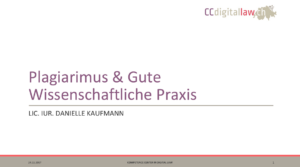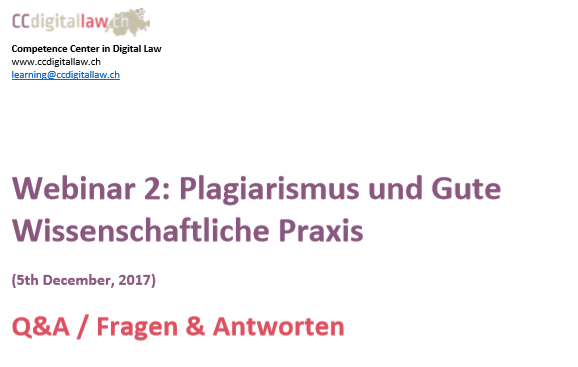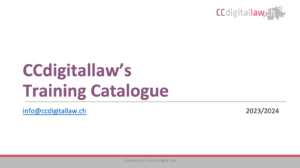How to avoid plagiarism
Have you ever written an article and wondered how to avoid plagiarism? Are you sure you cite sources correctly? Indeed, it is not always easy to know how to correctly report and refer to other people's ideas and results. However, incorrect behaviour can have negative consequences.
Here you can find a lot of information on what is good practice in this regard, how to correctly cite other people's work, how to avoid plagiarism and why it is important to respect other people's ideas.
Have a look at the FAQs to find answers to your questions on plagiarism, find more detailed explanations in the Knowledge Base and explore available training courses or webinars on the topic. In the last section you can find a selection of external resources on plagiarism.
FAQS
4.1.2-1 When I quote from a work, do I always have to mention the author?
Yes. Where the source indicates the author’s designation, the author’s name must also be cited, Art. 25 para. 2 CopA. It should be noted that quotations are not only governed by copyright law; it is also good scientific practice to provide correct quotations.
5.6-1 May a person cite excerpts of film, music and images?
Yes, even if they have been the subject of controversy in the literature to date, images and work excerpts are now recognised. However, in the process, it is important that you also disclose images, films and music as quotations, and correctly specify the source (Art. 25 CopA).
5.6-2 May I use a quotation in a work that has been put online? For example, an image or a music excerpt on my homepage?
Yes, pursuant to the law, it is irrelevant in which medium (book, pictorial, homepage, app, film,…) a quotation is used. However, it is decisive that the quotation has an explanatory, informational or illustrative function, is covered in the scope of the purpose of the quote, is disclosed as a quote, and the source is specified (Art. 25 para. 2 CopA).
5.6-3 May I just select an image from Google for a PowerPoint presentation and insert it into my presentation without any further ado?
If the image is a copyright-protected work (and that is generally the case), then it may only be used with the consent of the author and the owner of rights. However, the image can be entered into the presentation as a ‘pictorial quotation’. Then it has to serve an explanatory, informational or illustrative function, be covered in the scope of the purpose of the quote, be disclosed as a quote and the source specified (Art. 25 para. 2 CopA).
5.6-4 May I quote an unpublished work?
No, only published works may be quoted. However, in individual cases, the justification of the protection of legitimate interests may exist so that the quotation of unpublished works can also be justified. For example, public interest in a dispute with historical facts is ranked more highly than the interest of the author not to publish his work. (c.f. BVerfG, decision dated 17.12.1999 – 1 BvR 1611/99 in ZUM 2000, 316 in this regard).
5.6-5 May I cite an extract from a scientific article in which I am the co-author without citing exact sources in a new article?
No, if the source is not given, this is considered to be (auto-)plagiarism. In accordance with good scientific practice, you are not permitted to copy from yourself without disclosing that you have done so.
2.2.1-1 What can be problematic in the case of the copyright protection of scientific works?
The scientific idea is not protected by copyright. This includes statements, discoveries and results from states, events, research and other facts. These have no creative content of their own.
2.2.1-2 May a university lecturer use the biographical information from a PhD student’s thesis on the life and work of a psychoanalyst for a presentation without citing the thesis? Can this be considered an infringement of copyright?
No, because biographical data is considered to be in the public domain as it was not creatively developed by the PhD student (for more information, see the decision of the Federal Supreme Court BGE 113 II 306).
2.2.1-3 Is a theory presented in a scientific work protected by copyright?
Yes and no: the theory is not protected by copyright in its semantic content. It is a scientific statement and must be freely available to science. If the theory is designed creatively and individually in linguistic terms, it is at least protected in this linguistic form. If the theory is used word-for-word by a third party, the exception of quotation must be observed pursuant to Art. 25 CopA; otherwise, the presumption of a work exists (plagiarism).
2.2.1-4 Is a teaching book or a textbook protected by copyright?
Basically yes, when the textbook or parts of it have creative and individual elements. The form of representation in particular can be protected, i.e. the structure of the textbook, the way the contents are put together, the form of linguistic communication (e.g. through images, tables, diagrams, etc.), the language itself (e.g. for laypeople without specialist vocabulary or humorous descriptions).However, the (teaching) methods or the knowledge about them which is transmitted by the book are not protected because parts of already known, tested and researched matter are summarised for the purpose of knowledge transfer.
2.2.1-5 Are mathematical formulas, regulations or algorithms protected by copyright?
No, only when the developed formulas, regulations or algorithms are only rewritten exactly. Then there is no space for any creativeness. However, if they are recorded in specially thought up plans, tables, images, text descriptions, etc., they can be protected works if they are sufficiently original and individual.
6.5.2-1 If I fail to indicate a source I have used, can I be punished?
Any person who intentionally omits to indicate the source used where required by statute and where the author is named therein, and to provide the name of the source is liable to a fine on the complaint of the person whose rights have been infringed (Art. 68 CopA). Failure to indicate the source is punishable only following a complaint and is not considered to be a serious enough contravention to be entered on the offender’s criminal record.
In addition, failure to indicate a source at an academic level or in research is considered to be unethical (violation of good scientific practice) and may lead to disciplinary action.
KNOWLEDGEBASE
Find more detailed information on various aspects regarding how to avoid plagiarism:
TRAINING
Webinar on ‘Plagiarism and good scientific practice’
This webinar was presented in German by Danielle Kaufmann. Unfortunately, the recording of the webinar is not available.
Training Catalogue
A wide selection of training proposals can be found in the catalogue, including a course on ‘Plagiarism and good practice in academic writing’ (page 12).
ADVISING
For any questions please do not hesitate to contact us either by e-mail (info@ccdigitallaw.ch) or phone (+41 58 666 49 30).
EXTERNAL RESOURCES
Risorse video
Times I Plagiarized (by The Odd1sOut)
Websites / Swiss Resources
- Contribution on the Prevention of Plagiarism (of the Fachhochschule Nordwestschweiz) - de
- Rules for citation / Zitier-Knigge (of the ETH Zürich) - de
- Brochure "Plagiarism - Prevention and Measures" / Merkblatt "Plagiate - Prävention und Massnahmen" (by University Luzern) - de
International Websites
- Everything you need to know about plagiarism (www..plagiarism.org) - en
- European Network for Academic Integrity (www.academicintegrity.eu)
- Plagiarism Prevention Project of the University of Costance - de
- Safeguardiang Good Scientific Practice - Memorandum by Deutsche Forschungsgemeinschaft - de/en


